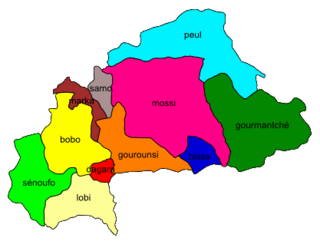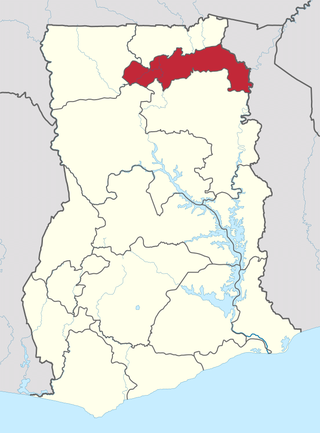Related Research Articles

The Dagaaba people are an ethnic group located north of the convergence of Ghana, Burkina Faso and Côte d'Ivoire. They speak the Dagaare language, a Gur language made up of the related Northern Dagaare dialects, Southern Dagaare dialects and a number of sub dialects. In northern dialects, both the language and the people are referred to as Dagara. They are related to the Birifor people and the Dagaare Diola. The language is collectively known as Dagaare, and historically some non-natives have taken this as the name of the people. One historian, describing the former usage of "Dagarti" to refer to this community by colonials, writes: "The name 'Dagarti' appears to have been coined by the first Europeans to visit the region, from the vernacular root dagaa. Correctly 'Dagari' is the name of the language, 'Dagaaba' or 'Dagara' that of the people, and 'Dagaw' or 'Dagawie' that of the land."

Sokodé is the second largest city in Togo, with a population of about 189,000. It is a commercial center for the surrounding agricultural areas, and seat of the Tchaoudjo Prefecture and Centrale Region. It is in the center of the country, 339 kilometres (211 mi) north of Lomé, between the Mo and Mono rivers. It is a multi-ethnic and multi-religious city, but is dominated by Islam. The ethnic majority are Kotokolis, who live alongside Muslims.
The Aja or Adja are an ethnic group native to south-western Benin and south-eastern Togo. According to oral tradition, the Aja migrated to southern Benin in the 12th or 13th century from Tado on the Mono River, and c. 1600, three brothers, Kokpon, Do-Aklin, and Te-Agbanlin, split the ruling of the region then occupied by the Aja amongst themselves: Kokpon took the capital city of Great Ardra, reigning over the Allada kingdom; Do-Aklin founded Abomey, which would become capital of the Kingdom of Dahomey; and Te-Agbanlin founded Little Ardra, also known as Ajatche, later called Porto Novo by Portuguese traders and the current capital city of Benin.

Kpalimé is a city in the Plateaux Region of Togo, 120 km north of Lomé and 15 km from the border with Ghana. It is the administrative capital of Kloto Prefecture. Kpalimé has a population of 75,084, making it the fourth-biggest town in Togo, after Lomé, Sokodé and Kara. The town has a cathedral, a scientific lycée, and a post-office, as well as several banks, medical centres, pharmacies, cyber-cafés and petrol stations.

The Brong-Ahafo region was a region in central Ghana. Brong-Ahafo was bordered to the north by the Black Volta river and to the east by the Lake Volta, and to the south by the Ashanti, Eastern and Western regions. The capital of Brong-Ahafo is Sunyani. Brong-Ahafo was created on 14 April 1959 from the then Western Ashanti and named after the main ethnic groups, the Brong and Ahafo. In 2019, as a result of the 2018 Ghanaian new regions referendum, the region was divided into three, namely Bono, Bono East and Ahafo regions, and ceased to exist.

The Nawdba, sing. Nawda, to whom some refer as Lossos in Togo, are an ethnic and linguistic group of people living in the Doufelgou District (Préfecture) of the Kara Region in Northern Togo, West Africa. The district capital is Niamtougou which is also an important regional market town. The Nawdba live on a plateau in the Togo Mountains between two mountain ranges: the Kabiyé Mountains to the South and the Défalé Chain to the North. They occupy the communities of Niamtougou, Koka, Baga, Ténéga, Siou, Djogrergou, Sioudouga, Kpadeba, Hago, Koukou, and Kounfaga. The Doufelgou District is bordered by the Kozah District to the South, by the Binah District to the East, by the Bassar District to the West, by the Kéran District to the North, and by the international border with Bénin to the Northeast.

The Ewe people are a Gbe-speaking ethnic group. The largest population of Ewe people is in Ghana, and the second largest population is in Togo. They speak the Ewe language which belongs to the Gbe family of languages. They are related to other speakers of Gbe languages such as the Fon, Gen, Phla /Phera, Ogun/Gun, Maxi, and the Aja people of Togo and Benin.

Ghana is a multilingual country in which about eighty languages are spoken. Of these, English, which was inherited from the colonial era, is the official language and lingua franca. Of the languages indigenous to Ghana, Akan is the most widely spoken in the south. Dagbani is most widely spoken in the north.
Bissa is a Mande ethnic group of south-central Burkina Faso, northeastern Ghana and the northernmost tip of Togo. Their language, Bissa, is a Mande language that is related to, but not the same as, a cluster of languages in the old Borgu Kingdom area of Northeast Benin and Northwest Nigeria, including Busa, Boko, and Kyenga. An alternate name for the Bissa is Busansi or Busanga which is used by the Mossi people.
Dambai is a city in Ghana and the administrative capital of the newly created Oti Region.
Siwu is a language that is spoken in the mountainous central part of the Volta Region of Ghana. It belongs to the geographic group of Ghana Togo Mountain languages of the Kwa branch of Niger–Congo. The speakers of Siwu call themselves the Mawu and their land Kawu. Some of the speakers of Siwu lives around Lolobi communities.

Bissa, is a Mande ethnic group of south-central Burkina Faso, northeastern Ghana and the northernmost tip of Togo. Their language, Bissa, is a Mande language that is related to, but not the same as, a cluster of languages in the old Borgu Kingdom area of Northeast Benin and Northwest Nigeria, including Busa, Boko, and Kyenga. An alternate name for the Bissa is Busansi which is used by the Mossi people and Kusasi people or Busanga.
The Guan-speaking Gikyode. Akyode people live in the northern Volta basin in the Oti Region of Ghana, Africa. They are considered as the indigenous people of the Nkwanta South District. These people migrated into the Volta valley from the Mossi region of Burkina Faso around 1000 AD. The Akyode language is called Gikyode.
The Guan or Guang people are an ethnic group found almost in all parts of Ghana, including the Akyode people who speak Gikyode,Krachi people, language-Kaakye people Nkonya tribe, the Gonja, Anum, Larteh, Akposo,Etsii in the Central Region, Nawuri,Nyagbo and Ntsumburu. The Guan are believed to have been the first settlers in modern day southern Ghana, migrating from the Mossi-Dagbon region of modern Ghana and Burkina around 1000 A.D. The Gonja of the Guan are however late settlers in northern Ghana, invading eastern Dagbon in the 1600s, capturing Daboya and many towns.
Kpassa is the capital of Nkwanta North District, a district in the Oti Region of Ghana. The Oti Region was part of the Volta Region of Ghana until 2019. The indigenous inhabitants of Kpassa are mainly Konkombas. In the past, the inhabitants of Kpassa have mainly engaged in farming. This trend has changed during the past two decades. Younger inhabitants are actively pursuing education and small-scale business activities, while the older ones are into governance. As a result, Kpassa has undergone rapid expansion during these past two decades. The town is expected to expand further once the Eastern Corridor Road Project is completed. In terms of architecture, a returning visitor will easily noticed that the town is rapidly shifting from mud buildings or atakpame to modern block buildings. In fact, most people in the town attach this shift to prestige and affluence in the society. At the current rate, one is expected to find fewer atakpame buildings a decade in the future. The economy of Kpassa is critical to the Volta Region, owing to its engagement in the production of valuable agricultural products such as corn, yam, cassava, millet, groundnuts, pepper, soya beans, and beans, among others.
Tem, or Kotokoli (Cotocoli), is a Gur language spoken in Togo, Ghana, Benin and Burkina Faso. It is used by neighboring peoples. In Ghana the Kotokoli people comes from a northern part of the Volta Region a town called Koue. Koue shares boarder with Togo with a small river which is called the Koue river separating it from Togo.
The Mampruli language is a Gur language spoken in northern Ghana, Northern Togo, Burkina Faso, Ivory Coast and Mali by the Mamprusi people. It is partially mutually intelligible with Dagbani. The Mamprusi language is spoken in a broad belt across the northern parts of the Northern Region of Ghana, stretching west to east from Yizeesi to Nakpanduri and centred on the towns of Gambaga, Nalerigu and Walewale.
Nawuri is a Guang language of Ghana. It is nearly intelligible with Kyode.

The North East Region is one of the sixteen regions of Ghana. It is located in the north of the country and was created in December 2018 after a referendum was voted upon to break it off of the Northern region. The region's capital is Nalerigu.
Shiare is a village mountain settlement in the Breast Mountains in the Oti region of Ghana. The Oti Region is in the northern part of the Volta Region. Shiare is a part of Nkwanta South Municipal District. It is noted that the village settlement is nine centuries old. It is north of the Oti Region in Ghana. The village is known as 'The Hanging Village'.
References
- 1 2 3 "Adele". ethnologue.com. SIL International. 2015. Retrieved 23 January 2018.
- ↑ Olson, James Stuart (1996). The Peoples of Africa: An Ethnohistorical Dictionary. Westport: Greenwood Press. p. 8. ISBN 0313279187. OCLC 32968738.
- ↑ Lentz, Carola; Nugent, Paul (2016). Ethnicity in Ghana: The Limits of Invention. New York City: Springer. p. 163. ISBN 978-1349623372 – via Google Books.
- ↑ Poidi-Gblem, Honorine Massanvi; Kantchoa, Laré Pierre (2012). "Les langues du Togo: État de la recherche et perspectives". Editions l'Harmattan (in French).
- ↑ Bashiru Zakari, Alhaji (6 December 2016). "Kotokolis Also Voted to Become Ghanaians as Others". modernghana.com. Modern Ghana. Retrieved 23 January 2018.
- ↑ Kropp, Mary E. (2015). The Languages of Ghana. Abingdon, United Kingdom: Routledge. pp. 120–125. ISBN 9781317406044.
- ↑ "Adele Women Association - Nkwanta 'Upper Volta' Ghana".
- ↑ "Adele Women Association (Ghana) and the Permaculture Intensive". 2012-09-26.